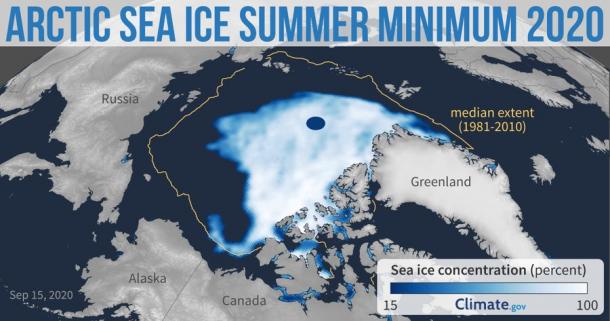22 September 2020. Arctic sea ice – a key climate change indicator – has reached its annual minimum extent after the summer melt season. It was the second lowest extent only after the record low observed in 2012.
The U.S. National Snow and Ice Data Center (NSIDC) announced that on 15 September, sea ice extent was 3.74 million square kilometres (1.44 million square miles). The Alfred Wegener Institute Institute confirmed this reading, with figures from the University of Bremen saying it was 3.8 million square km. Other space agencies and data providers, for example, EUMETSAT Ocean and Sea Ice Satellite Application Facility (OSI SAF) and Japan’s Aerospace Exploration Agency (JAXA) concur that the second-lowest sea-ice extent was reached this year.
The 2020 figure—preliminary because a late-season surge of summer warmth could still drop the extent further—continued an observed trend of long-term Arctic sea ice decline.
The last 14 years—2007 to 2020—have the lowest 14 minimum extents of the 42-year satellite record.
There are a number of causes for the massive loss of ice this summer. This includes extremely high air and water temperatures. Accordingly, heat impacted the ice from both above and below, resulting in widespread melting.
A record-breaking heatwave and unprecedented wildfires in Siberia were a major contributing factor during a northern hemisphere summer which will leave a deep wound in the cryosphere, with major impacts on ice shelves and glaciers in the northern hemisphere.
“It’s been a crazy year up north, with sea ice at a near-record low, 100-degree (Fahrenheit) heat waves in Siberia, and massive forest fires,” said Mark Serreze, director of NSIDC. “The year 2020 will stand as an exclamation point on the downward trend in Arctic sea ice extent. We are headed towards a seasonally ice-free Arctic Ocean, and this year is another nail in the coffin.”
“This threshold means the Arctic is more ocean than ice, a blue highway that’s been open since mid-July and won’t close until well into October,” said Ted Scambos, a senior research scientist at the Earth Science Observation Center at the University of Colorado-Boulder.
Temperatures in the Arctic are rising more than twice as fast as the global average. Unique amplification processes and feedbacks, such as the rapid decline of sea ice, significantly contribute to this warming. The consequences of a warming Arctic will be far-reaching across the northern hemisphere.
The fast-warming Arctic has started to transition from a predominantly frozen state into an entirely different climate, according to a comprehensive new study of Arctic conditions by scientists at the National Center for Atmospheric Research (NCAR).
See here: https://public.wmo.int/en/media/news/arctic-sea-ice-minimum-2nd-lowest-record.
Read more: UNRIC Library Backgrounder on Oceans




